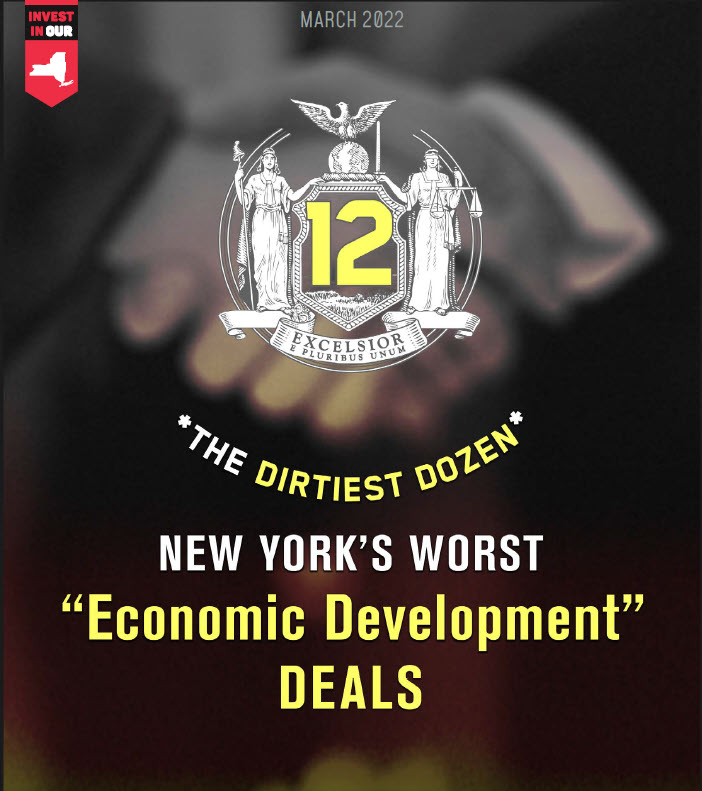
The Dirtiest Dozen: New York’s Worst Economic Development Deals

The Dirtiest Dozen: New York’s Worst Economic Development Deals
New York State is one of the most prolific users of so-called “economic development” incentives in the country, spending some $10 billion annually at the state and local level on subsidies to select businesses. For all that, New York has very little to show other than empty factories, underwhelming job-creation numbers, and a slew of corruption scandals.
Instead of addressing these obvious problems, Gov. Hochul has proposed to double spending at the Empire State Development Corporation – literally doubling down on failure.
It’s time to try something new. But to truly reform the economic development system so that it focuses on people, communities, and local businesses, policymakers have to understand what went wrong.
This paper covers 12 of the worst New York economic development deals: a dirty dozen of failure.
This is just the tip of the iceberg, but it provides a sense of the many ways in which New York’s dependence on corporate subsidies has done the state’s residents wrong, and why a complete overhaul of the system is such an urgent priority.
- NEW YORK’S MOST EXPENSIVE SUBSIDY: $4 MILLION PER JOB


- Plug Power: The most expensive economic development deal in New York history on a per-job basis, the clean energy corporation Plug Power received nearly $270 million to create just 68 jobs at a plant at the Science and Technology Advanced Manufacturing Park site in Genesee County – and that amount doesn’t factor in the costs of local infrastructure to service the plant. The total cost to taxpayers is $4 million per job
 .
.
- EMPTY FACILITIES & EMPTY PROMISES IN CENTRAL & WESTERN NEW YORK

- Semiconductor Shell Game: The STAMP site – which cost taxpayers $26 million to build – is part of a much larger failed push to attract a semiconductor manufacturer to New York that also includes the $3.2 million White Pine Commerce Park in Onondanga County, which has had no tenant for 20 years. State officials have proposed massive subsidy packages for semiconductor corporations to come to one of those two largely empty sites, including $1.9 billion for a Samsung plant that ultimately went to Austin, Texas. Gov. Hochul is reportedly currently negotiating with a semiconductor manufacturer to move to STAMP, though she refuses to identify which one. The state also paid the largest cash grant ever awarded in the U.S. to the semiconductor firm GlobalFoundries, as part of a massive $1.4 billion incentive package.

- BILLIONS FOR A BILLIONAIRE DON’T PAY OFF FOR NEW YORKERS

- Tesla and Solarcity: Former Gov. Andrew Cuomo’s Buffalo Billion revitalization plan centered around a state-funded $950 million solar panel plant for SolarCity, a subsidiary of Tesla, in South Buffalo. The plant currently employs far fewer workers than the 3,000-plus predicted by the governor. A state audit found the state’s investment has produced only 54 cents on the dollar for the public. New York State has also begun to sell off more than $200 million in manufacturing equipment that it bought for the Tesla and Panasonic solar manufacturing facilities.

- BUFFALO BILLION REDUCES TECH HIRING, INCREASES CORRUPTION

- The Rest of the Buffalo Billion: The Tesla investment was part of a much larger failed initiative from Cuomo and Hochul named the Buffalo Billion, a $1 billion spending plan intended to bring tech and manufacturing companies to the Buffalo area. Instead, what the public received was lower rates of tech and manufacturing sector employment in the region and a slew of administration insiders and developers convicted of corruption charges for steering public funds to particular corporations and individuals. As then-U.S. Attorney Preet Bharara put it, “the bids were rigged and the results were preordained. Companies got rich and the public got bamboozled.”

- A TOTAL FLOP: CUOMO’S MULTI-MILLION DOLLAR FILM STUDIO
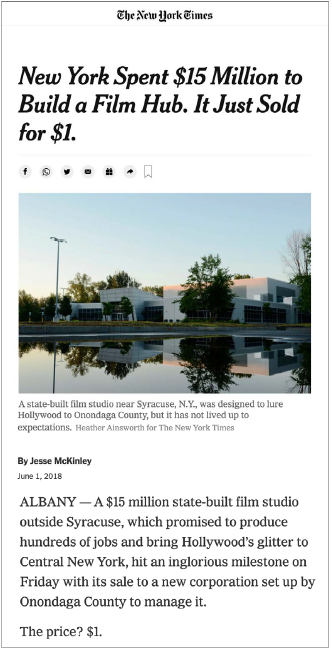
- The Central New York Film Hub: The Central New York Film Hub is a movie studio outside Syracuse, which cost $15 million in public funds to build, but was sold for just $1 to a new corporation set up by Onondaga County itself, despite Cuomo boasting in 2014, “Who would have ever figured: Hollywood comes to Onondaga, right?” No major films were ever shot at the studio.
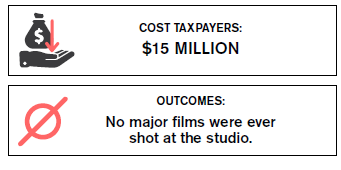
- BILLIONS FOR A BILLIONAIRE DESTROYING SMALL NEW YORK BUSINESSES

- Massive Giveaways to Amazon: New York localities have given away huge subsidies to Amazon to help the e-retail platform build out its distribution and warehousing network, including $150 million from Gates, $70 million from Clay, $21 million from Montgomery, $20 million from Greece, $18 million from East Fishkill, $13 million from Schodack, and $6 million from Hamburg. As many analysts have pointed out, these handouts undermine local businesses, harm workers, and have nothing to do with where Amazon chooses to locate, as those decisions are based on many other factors such as access to Prime customers, the area’s disposable income, and access to transportation infrastructure.

- FACILITATING FRAUD: CORRUPT COMPANY CHASES IDA PAYOFF
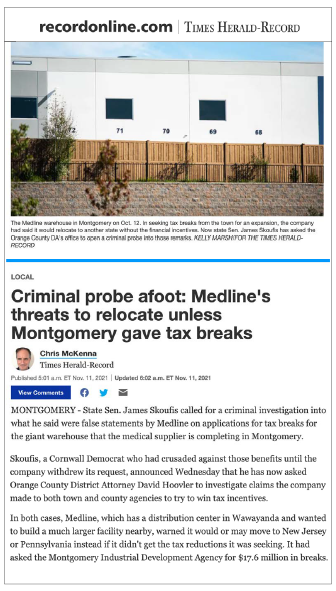
- Medline Lies: Medline, a manufacturer and distributor of pharmaceutical supplies, threatened to move a warehouse project in Montgomery to New Jersey or Pennsylvania if its application for a local IDA tax break was rejected. When it didn’t receive the tax break, Medline built the warehouse anyway, highlighting that development incentives almost always play no role in corporate location decisions. Sen. James Skoufis has referred a case against Medline to the Orange County DA for potential prosecution for lying on government documents.
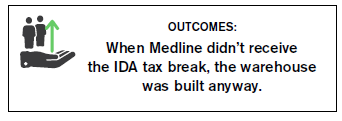
- YET ANOTHER EMPTY TAXPAYER-FUNDED FACTORY SCAM
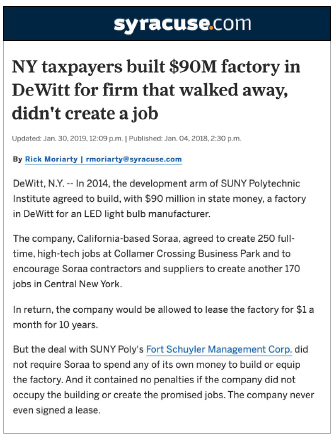
- Soraa LED Lighting: The state built a $90 million factory for the Soraa LED lighting company, which walked away from the deal with no penalty, and which spent none of its own money on the project. The state then committed up to $15 million more so NexGen Power Systems, a semiconductor company, would retrofit and lease the plant. NexGen then received $3 million more in property tax reductions, as well as tax breaks on equipment and construction materials.
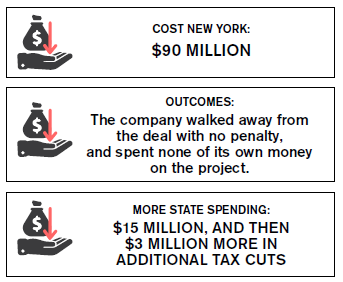
- MILLIONAIRES’ HORSES GET MORE THAN FARMERS OR VETERANS
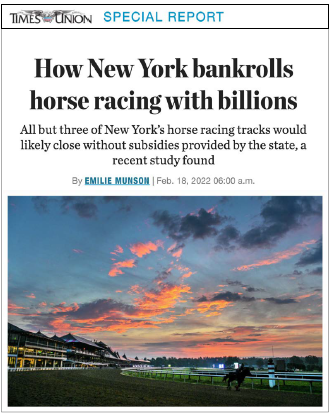
- Horse Racing Subsidies: New York has spent $2.9 billion subsidizing horse racing tracks in the name of economic development since 2008, yet only three of the state’s 15 tracks are profitable. The rest are kept afloat solely thanks to economic development spending. As a thorough Times-Union investigation pointed out, the amount racing tracks are subsidized is “more than twice the money New York budgeted for the state Department of Agriculture in the same time period, and 13 times what it spent on veterans’ services.” But the state doesn’t know how many jobs the tracks support or the economic impact they provide.

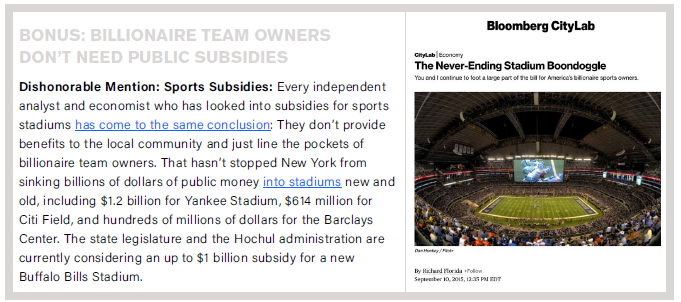
- STATE SUBSIDIES FOR REAL ESTATE BILLIONAIRES & LUXURY HOUSING
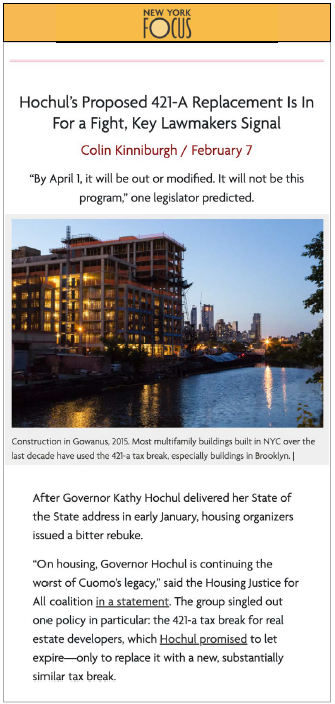
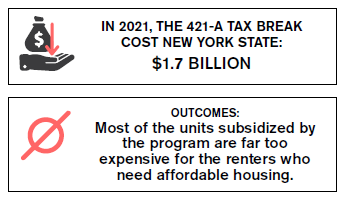
- 421-a Housing Handout: The 421-a housing handout is consistently the most expensive tax break in New York State, costing $1.7 billion in fiscal year 2021 alone – 10 times more than it cost in 2001 – and doling out tax breaks to developers that last for literally decades. For all that money, New York gets little in the way of housing affordability, with most of the units subsidized by the program still far too expensive for the renters who need affordable housing. 421-a is scheduled to expire at the end of the year.
- MORE NEEDLESS SUBSIDIES FOR VALUABLE MANHATTAN REAL ESTATE
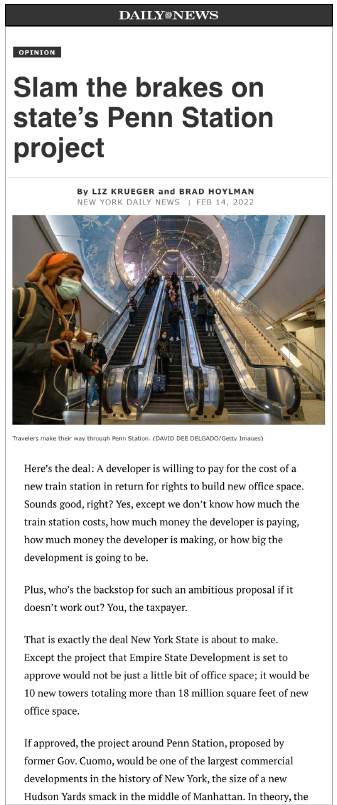
- Penn Station Boondoggle: One of Gov. Hochul’s top priorities is the redevelopment of Penn Station and Madison Square Garden, which involves a likely massive – and to date undisclosed – subsidy to the developer Vornado that could total billions of dollars. The state is also on the hook for any potential cost overruns. Already, Madison Square Garden is the recipient of a massive $44 million annual tax break that has cost the city more than half a billion dollars in total.
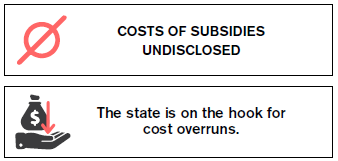
- HUDSON YARDS COST US BILLIONS – ANOTHER SUBSIDY FOR A BILLIONAIRE
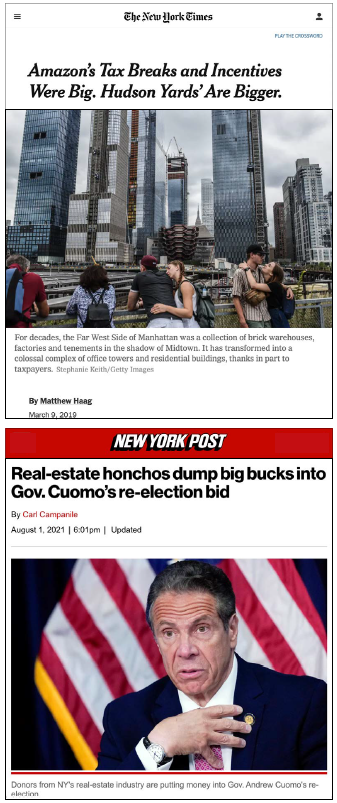
- Hudson Yards: Hudson Yards developers benefit from $1.1 billion in IDA handouts, a total that is likely to climb higher as more commercial and retail buildings are constructed. The area also benefited from billions of dollars in special infrastructure favors that could have been spent on broader city benefits. Researchers had to use open records law to access some of the numbers, as they weren’t all publicly disclosed.
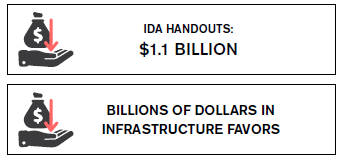
BONUS: BILLIONAIRE TEAM OWNERS DON’T NEED PUBLIC SUBSIDIES
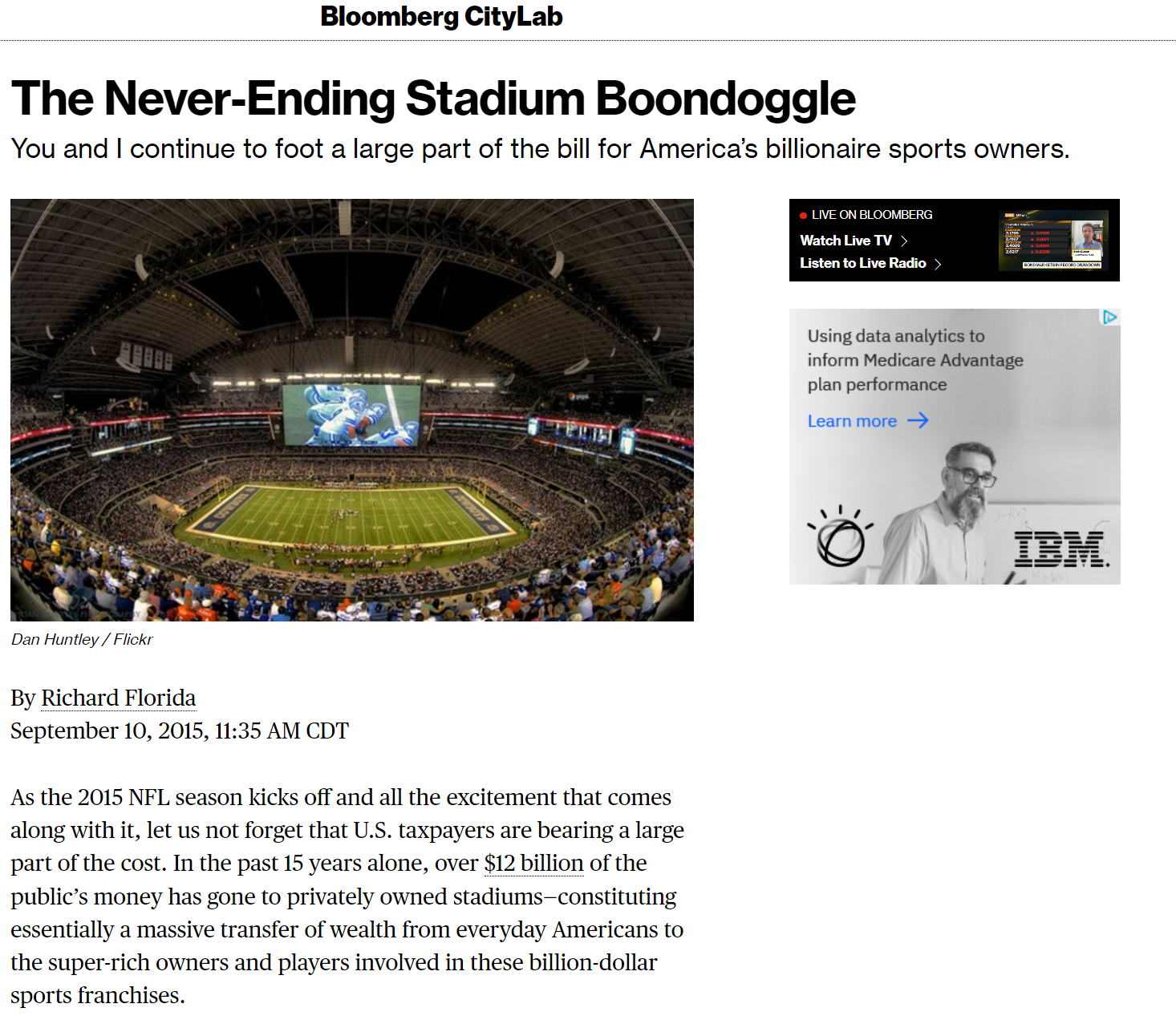
Dishonorable Mention: Sports Subsidies: Every independent analyst and economist who has looked into subsidies for sports stadiums has come to the same conclusion: They don’t provide benefits to the local community and just line the pockets of billionaire team owners. That hasn’t stopped New York from sinking billions of dollars of public money into stadiums new and old, including $1.2 billion for Yankee Stadium, $614 million for Citi Field, and hundreds of millions of dollars for the Barclays Center. The state legislature and the Hochul administration are currently considering an up to $1 billion subsidy for a new Buffalo Bills Stadium.

